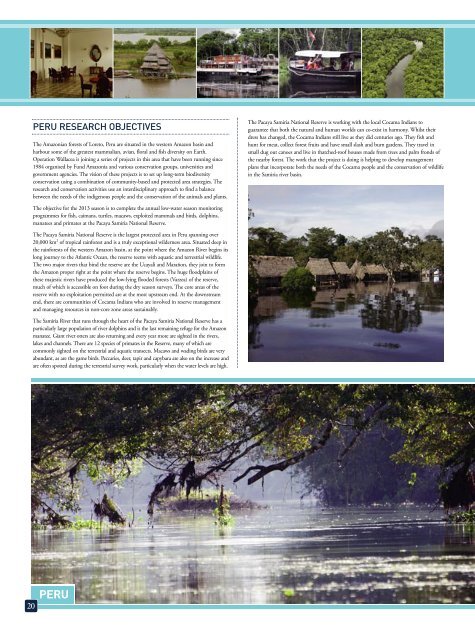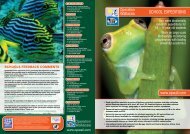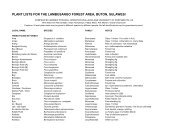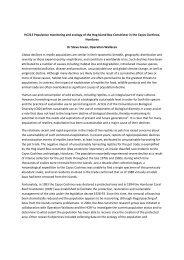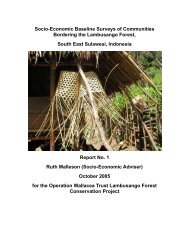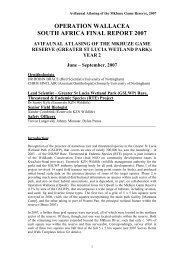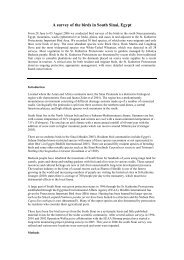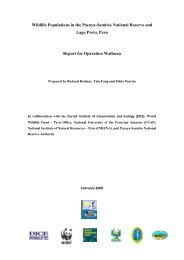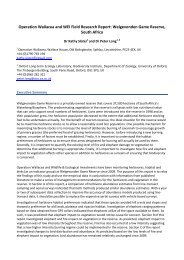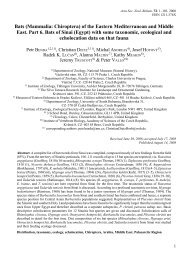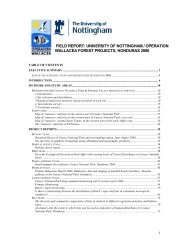Download the 2013 programme - Operation Wallacea
Download the 2013 programme - Operation Wallacea
Download the 2013 programme - Operation Wallacea
Create successful ePaper yourself
Turn your PDF publications into a flip-book with our unique Google optimized e-Paper software.
20<br />
PERU RESEARCH OBJECTIVES<br />
The Amazonian forests of Loreto, Peru are situated in <strong>the</strong> western Amazon basin and<br />
harbour some of <strong>the</strong> greatest mammalian, avian, floral and fish diversity on Earth.<br />
<strong>Operation</strong> <strong>Wallacea</strong> is joining a series of projects in this area that have been running since<br />
1984 organised by Fund Amazonia and various conservation groups, universities and<br />
government agencies. The vision of <strong>the</strong>se projects is to set up long-term biodiversity<br />
conservation using a combination of community-based and protected area strategies. The<br />
research and conservation activities use an interdisciplinary approach to find a balance<br />
between <strong>the</strong> needs of <strong>the</strong> indigenous people and <strong>the</strong> conservation of <strong>the</strong> animals and plants.<br />
The objective for <strong>the</strong> <strong>2013</strong> season is to complete <strong>the</strong> annual low-water season monitoring<br />
<strong>programme</strong>s for fish, caimans, turtles, macaws, exploited mammals and birds, dolphins,<br />
manatees and primates at <strong>the</strong> Pacaya Samiria National Reserve.<br />
The Pacaya Samiria National Reserve is <strong>the</strong> largest protected area in Peru spanning over<br />
20,000 km 2 of tropical rainforest and is a truly exceptional wilderness area. Situated deep in<br />
<strong>the</strong> rainforests of <strong>the</strong> western Amazon basin, at <strong>the</strong> point where <strong>the</strong> Amazon River begins its<br />
long journey to <strong>the</strong> Atlantic Ocean, <strong>the</strong> reserve teems with aquatic and terrestrial wildlife.<br />
The two major rivers that bind <strong>the</strong> reserve are <strong>the</strong> Ucayali and Marañon, <strong>the</strong>y join to form<br />
<strong>the</strong> Amazon proper right at <strong>the</strong> point where <strong>the</strong> reserve begins. The huge floodplains of<br />
<strong>the</strong>se majestic rivers have produced <strong>the</strong> low-lying flooded forests (Varzea) of <strong>the</strong> reserve,<br />
much of which is accessible on foot during <strong>the</strong> dry season surveys. The core areas of <strong>the</strong><br />
reserve with no exploitation permitted are at <strong>the</strong> most upstream end. At <strong>the</strong> downstream<br />
end, <strong>the</strong>re are communities of Cocama Indians who are involved in reserve management<br />
and managing resources in non-core zone areas sustainably.<br />
The Samiria River that runs through <strong>the</strong> heart of <strong>the</strong> Pacaya Samiria National Reserve has a<br />
particularly large population of river dolphins and is <strong>the</strong> last remaining refuge for <strong>the</strong> Amazon<br />
manatee. Giant river otters are also returning and every year more are sighted in <strong>the</strong> rivers,<br />
lakes and channels. There are 12 species of primates in <strong>the</strong> Reserve, many of which are<br />
commonly sighted on <strong>the</strong> terrestrial and aquatic transects. Macaws and wading birds are very<br />
abundant, as are <strong>the</strong> game birds. Peccaries, deer, tapir and capybara are also on <strong>the</strong> increase and<br />
are often spotted during <strong>the</strong> terrestrial survey work, particularly when <strong>the</strong> water levels are high.<br />
PERU<br />
The Pacaya Samiria National Reserve is working with <strong>the</strong> local Cocama Indians to<br />
guarantee that both <strong>the</strong> natural and human worlds can co-exist in harmony. Whilst <strong>the</strong>ir<br />
dress has changed, <strong>the</strong> Cocama Indians still live as <strong>the</strong>y did centuries ago. They fish and<br />
hunt for meat, collect forest fruits and have small slash and burn gardens. They travel in<br />
small dug out canoes and live in thatched-roof houses made from trees and palm fronds of<br />
<strong>the</strong> nearby forest. The work that <strong>the</strong> project is doing is helping to develop management<br />
plans that incorporate both <strong>the</strong> needs of <strong>the</strong> Cocama people and <strong>the</strong> conservation of wildlife<br />
in <strong>the</strong> Samiria river basin.


